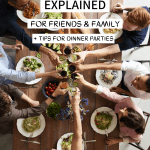
The low FODMAP diet for friends and family
You are that girl who can’t eat many things right? What was it again that you are doing? Do you have a gluten intolerance? How is your diet going, can you already eat a bit more?
These are things that I used to hear often in my surroundings when I just started the FODMAP diet. A lot of people actually didn’t understand what I am doing and what the low FODMAP diet entails.
From other fodmappers, I often hear that family and friends make comments about their diet.
They say things like: “Why are you following a diet, that is really not necessary!” or “Did you fall for another of those diet hypes?” or “Ah come on, one bite won’t hurt”.
Comments like these can be very frustrating because the low FODMAP diet is a difficult diet and you would like to feel supported by your friends and family on this journey, instead of them questioning your diet.
In this blog, I want to tell you how I explain to other people what the low FODMAP diet is and why there are so many things that I can’t eat.
I have noticed that, since I explain what the diet is in this way, people never react in a weird way about my diet, but they actually show interest and understanding.
I hope that this explanation can help you to make the people around you understand your diet better. Next to that, I also share my tips to make dinner parties easier. Both for the host and for yourself!
How do you explain what the low FODMAP diet is?
I have two versions of my explanation. One short version for when I quickly want to explain why there are so many things that I can’t eat and one longer version for people who show interest and want to know more about the diet:
The short version
When I quickly want to explain and don’t have time to go into depth, this is what I say:
I have the Irritable Bowel Syndrome and therefore I get stomach pains very quickly. I follow a medical diet, prescribed by a doctor or dietician, which helps me to limit and control these stomach issues.
This is quite a limiting diet and there are several food groups that I have to avoid. Some of the things that I cannot eat are for example: onion, garlic and wheat.
The long version
If there is a bit more time to explain or when people show interest, I tell them this:
I have the Irritable Bowel Syndrome (IBS) and I follow a low FODMAP diet because of that. IBS is a chronic gut disorder that causes a lot of stomach problems. The low FODMAP diet is a medical diet that is prescribed by a doctor or dietician to control your symptoms.
In the beginning of the diet, you remove several food groups from your diet and you try to get your symptoms under control. When your symptoms have improved, you are going to test these groups one by one to see how you react to them.
After these tests, you know which food groups trigger your symptoms.
I have followed this diet and I know to which food groups I react now. But because there were several groups that I reacted to, I still have to avoid those foods.
For me those foods are, for example, onion, garlic and wheat. Because of this, I have to pay attention to what I eat and I cannot eat everything. If I eat something I don’t tolerate, it will cause severe stomach issues.
I add the second part because I have finished the elimination and reintroduction phases. If you are still at the start of the diet, you can say that you have just started or that you are testing foods now.
I always call the low FODMAP diet a medical diet that is prescribed by a doctor or dietician, so people understand immediately that this is not some diet hype or that I just want to lose weight. This helps them take my diet seriously.
What if they want to know more?
Especially for people that are close to you, like your parents, kids or partner, it can be nice to understand the low FODMAP diet a little better than the quick explanation that I have given above.
If you want to explain to somebody in a bit more detail what FODMAP means and which things you can and cannot eat. I advise you to let them read the following blogs:
- What is the low FODMAP diet?
- The elimination phase
- The reintroduction phase
- What can and can’t you eat on the low FODMAP diet?
Dining with family and friends
The next step is when you have a dinner party at somebody else’s place and they have to take your diet into account when they cook for you. The last thing that you want, is to be at a birthday or dinner party where you cannot eat anything.
But you also don’t want people to see you as that difficult person that they don’t really want to cook for. I have found a way to make eating with friends and family as simple as possible for both you and the host. In the next steps, I explain how I prepare for dinner parties:
Step 1: Tell the host that you have intolerances on time
If you tell somebody on the evening of party that you have a lot of intolerances, it is going to be very difficult to make something for you.
Let them know on time and be very clear about your diet. Give the explanation that I have given above when somebody doesn’t know about your diet yet. Like this, they know that it is serious.
Step 2: Make it easy for the host
The low FODMAP diet is difficult and it isn’t nice for you when people make mistakes when cooking for you.
On the other hand, I also understand that a host won’t really know what to do when somebody turns up with a huge list of things that they cannot eat. Remember that it is also difficult for them. I always do one of the following things to help:
- I ask what the host is planning to make. Then I give suggestions of how we could make that meal low FODMAP and which ingredients are necessary for that.
- I offer to come early and help with the cooking. Like this, I can make sure that nothing goes wrong with the ingredients and it makes it less difficult for the host.
- I bring some low FODMAP ingredients. For example: when we have a BBQ, I often bring my own bread and sauces.
Or when we make pasta for a dinner with friends, I bring gluten-free pasta. Like this, the host doesn’t have to buy special gluten-free products for me (some people really don’t mind about this, but I like to offer to bring it myself). - I send the host a few recipes from my blog, to give ideas for what to cook. This is even easier, all ingredients are low FODMAP and they just have to follow the recipe.
- I offer to do part of the cooking myself, so they don’t have to do everything. For example a side dish or dessert.
Step 3: Check with the host how they prefer to do it
For me it really differs per host how we deal with the low FODMAP cooking. Some of my friends that I don’t see that often find my diet really difficult and don’t know how to cook something for me.
When I eat with them, we often decide beforehand what we will cook and then I will make some adaptations for myself and bring some low FODMAP ingredients. Then I often help with the cooking.
People who know a bit more about my diet often don’t mind to cook something for me by themselves. My mother, for example, usually asks me if I can help her decide what to cook for a birthday party that I am joining.
We talk about what we are going to make in advance and I do suggestions for the low FODMAP part. Often I also end up making something or I help her with the cooking.
But after all these years, she knows very well what I can and can’t eat and she always has some low FODMAP foods in her pantry, such as lactose-free milk or gluten-free bread. So for her, cooking low FODMAP is not so difficult anymore.
Also my friends, who I see often, know my diet quite well. They really like cooking a recipe from my blog when we eat together. And also when we get together for drinks or a party people often make recipes from my blog, so I can eat something too.
That is really nice! Sending people some of your favourite low FODMAP recipes will make it easier for them to cook something for you.

One of my friends even goes a step further. She loves to bake, just like me, and she always likes to bake something for her birthday party that I can eat too.
Often she finds a recipe herself and then asks me how she can tweak it to make it low FODMAP. Like that, I can eat birthday cake too. Really sweet!
Of course, it sometimes happens that I go to a birthday party and there is not much that I can eat. Often I haven’t told the host anything about my diet then and they didn’t think about it themselves either.
But even then, there is usually something that I can eat, like some snack veggies (like cucumbers or tomatoes) or some plain chips. And the fact that I have to skip the cake for once, doesn’t bother me so much.
With some people, like my grandma, I just bring something myself if I really want to eat something when visiting. From my grandma, who is in her eighties, I don’t expect that she understands my diet and can accommodate for it.
So when I go to eat with her, I call her in advance and tell her that I will cook something for us or I bring some cake to enjoy eat together, so she doesn’t have to think about it.
By approaching my dietary limitations like this and not expecting other people to just adapt everything for me, I almost only have positive experiences with dinner parties.
Because I share ideas and offer to help, nobody finds it a problem to accommodate for me.
I hope that this blog has been useful to you, to explain to the people around you what this diet is and to make it easier to eat together with friends and family. What is your experience with dinner parties?
Together we go for a calm belly!
Subscribe to the Karlijn's Kitchen e-mail newsletter for more tips and recipes and receive the ebook 10 things I wish I had known when I started the FODMAP diet for free!


5 Comments
Thank you for this. It’s been an incredibly frustrating time for everyone, especially around the holidays. I have always been a foodie so making anything for me was not a problem, you put it in front of me and I would eat it. Now I have to look at the ingredients on every little thing, ask what spices someone used, etc. Grocery Shopping is a nightmare what used to take me 30minutes is now a 5 hour journey of self discovery and tears (I’ve broken down in the fetal aisle more than once). The worst part is is I don’t have the ability to start adding medium and high fodmap items to my diet, this is my diet and I must stick to it or be in extreme pain for 3+ days. I have sent this to friends and family in hopes that we can get through this together! Thank you so much for sharing this, you are a saint!
My husband was recently advised by his doctor to follow a low FODMAP diet due to his stomach issues and he’s been very frustrated by it. This article was incredibly helpful for me to understand the “why” behind High versus Low FODMAP foods. Thank you for writing this up – it was truly, truly help!
Glad to hear that, Becky! You’re welcome 🙂 Good luck for your husband with the low FODMAP diet. It does get easier with time!
Thank you so much for the explanation and all the delicious recipes! I am new to the diet, and a little confused, but reading your blog gives me hope!
Thank you and happy holidays!
These are all some great suggestions. I have friends who like to make recipes from my blog too, and often surprise me with it. Makes me feel so loved! I love the suggestion of bringing something myself too. That’s usually my go=to, especially for family that I don’t see as often or friends who aren’t big into cooking. Love the ideas on what to say to family and friends when they make comments about the diet! It’s such a tricky and frustrating subject, and it’s nice to have an answer ready. I have the tendency to get embarrassed by my dietary needs, both my allergies and my intolerances, which is not a good way to deal with it. Those comments are truly helpful! I also make sure I’m strict when I’m at home so that when I do go out and have something I don’t react nearly as strongly and I don’t have to be quite as careful. Sometimes it works, sometimes it makes me miserable all night haha.